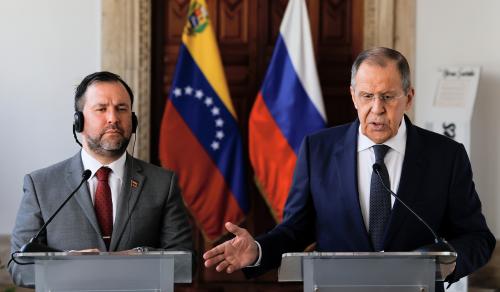Content from the Brookings-Tsinghua Public Policy Center is now archived. Since October 1, 2020, Brookings has maintained a limited partnership with Tsinghua University School of Public Policy and Management that is intended to facilitate jointly organized dialogues, meetings, and/or events.
This week, the United States is hosting the inaugural U.S.-China Comprehensive Economic Dialogue, co-chaired by Treasury Secretary Steven Mnuchin, Commerce Secretary Wilbur Ross, and Chinese Vice Premier Wang Yang. The dialogue serves as the principal forum for Washington and Beijing to address trade and investment issues. This week’s session is likely to produce agreement on a one-year action plan for tackling trade and investment impediments, building on the 100-day plan inked at President Trump’s April meeting with Chinese President Xi Jinping.
However, to the consternation of some in the U.S. business community, the new action plan likely will be general and non-specific, focusing more on principles and shared commitments than concrete steps or detailed deliverables. More broadly, we do not expect either side will take steps at this dialogue that would alter the trajectory of bilateral trade and investment, dynamics that have been markedly stable to date this year. Trump’s approach thus far demonstrates broad continuity with that of his predecessors—encouraging further Chinese opening while refraining from steps that might undercut the bilateral economic relationship.
There are four primary reasons for restrained expectations surrounding the upcoming talks.
- The United States will not make concessions on China’s priorities. The United States will not recognize China as a market economy, and will not entertain requests to loosen export controls on high-tech products or make it easier for Chinese firms to invest in the United States unless/until China takes reciprocal steps to improve market access for U.S. firms in China. The United States also is not prioritizing negotiation of a bilateral investment treaty with China amid the various competing priorities facing the U.S. trade representative, such as renegotiating NAFTA and the U.S.-Korea Free Trade Agreement.
- China does not feel pressure to cave to U.S. demands. The 100-day action plan produced only modest results—primarily opening the beef market in China to American products. Still, the Trump administration hailed the outcome, with President Trump praising the progress on Twitter, Secretary Ross hailing it as a “herculean accomplishment,” and Secretary Mnuchin stating that he “couldn’t be more pleased.” Privately, administration officials also have been signaling to Beijing that they understand that trade imbalances and market access challenges will take time to resolve. These private and public signals relieve pressure on Beijing to make near-term concessions and allows China to use processes—dialogues, roadmaps, and political commitments—to lend the appearance of constructive engagement in addressing longstanding irritants.
- This is a political year in China, with the 19th Party Congress slated for autumn. The Party Congress is a once-every-five-year event at which the top leadership turns over. President Xi will certainly remain in place, but there is much uncertainty and political jockeying over all other senior positions. In this environment, no senior Chinese official will want to invite any appearance of capitulation to U.S. pressure, given the negative effect such a perception would engender for his/her standing within the Chinese leadership. “Stability” is the watchword for the year in terms of China’s macroeconomic policies and performance and its structural policies. There will almost certainly not be any important policy announcements at the dialogue, such as broad opening of the many still-closed sectors in the economy. Whether the new political line-up moves faster on reform likely will not be known until after the National People’s Congress in March 2018. 2017 is not a promising year to negotiate reforms with China.
- A potential U.S. decision on steel tariffs will cast a cloud of uncertainty over the talks. It is unlikely that the steel decision will be announced before the dialogue begins, but the expectation of U.S. action on steel will affect the meeting. In reality, the United States imports very little steel from China (less than five percent of steel usage); the major exporters to the United States are Canada, Mexico, South Korea, and others. Still, China’s large excess capacity and exports to other parts of the world market are problematic and worthy of discussion between the two sides. However, these are not problems that can be solved by American tariffs, which will hurt mostly U.S. allies and U.S. firms and workers in industries that use steel, while having only a small, indirect effect on China. Any significant tariffs on steel could signal a more protectionist U.S. stance, which would affect China directly, and likely lead to a hardening of China’s positions vis-à-vis the United States.
While the upcoming economic dialogue may not produce detailed deliverables, trade and investment between China and the United States continues to grow. Through May, according to the most recent U.S. data, American merchandise exports to China increased 17 percent from the year before, while imports grew eight percent. China’s economy is growing much faster than the U.S. economy, and the Chinese market remains important for some U.S. industries. If those trends continue, the big trade imbalance between the two countries will decline in the long run. The healthy growth of U.S. exports to a fast-growing Chinese market is one reason to tread lightly with protectionist measures that would invite retaliation.
In the short run, however, the imbalance continues to widen. The bilateral imbalance has increased five percent so far this year (our exports may be growing rapidly, but from a low base). In this complex environment, the Trump administration probably will continue the policy of the last two presidents—cajoling China to open up more, but avoiding harsh measures that would impede the economic relationship.





Commentary
Expect more process than progress at U.S.-China Comprehensive Economic Dialogue
July 18, 2017